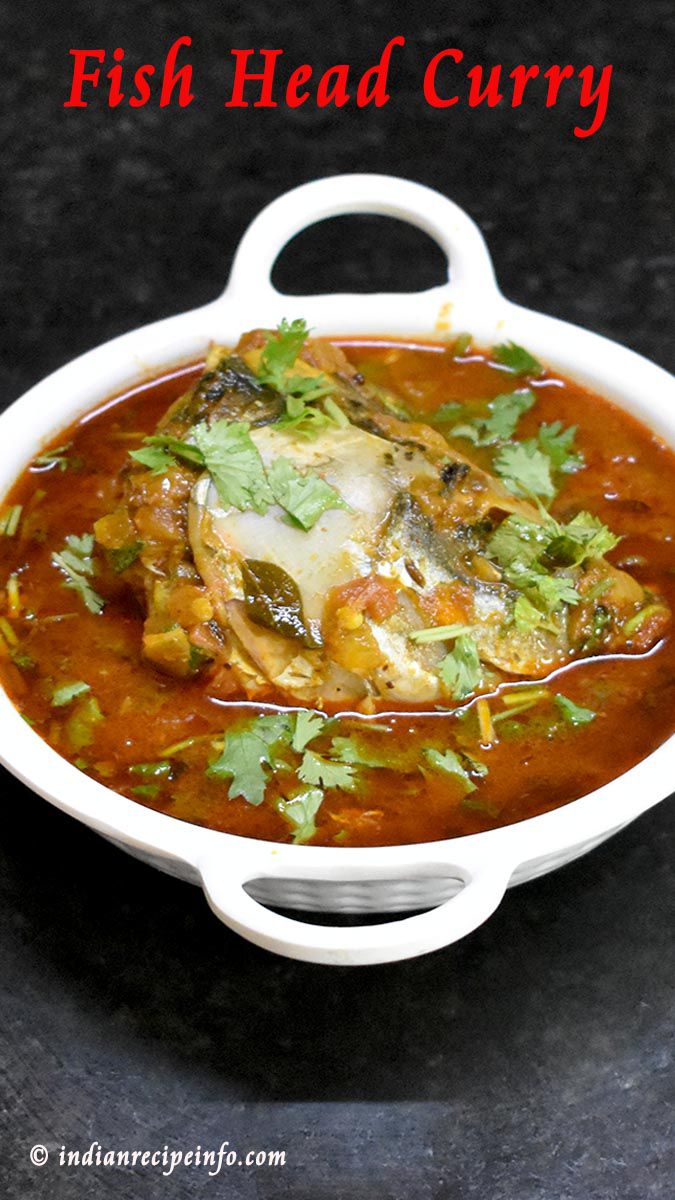Peanut Coconut Chutney Recipe for Idli & Dosa
Peanut Coconut Chutney Recipe is a popular South Indian condiment made by blending fresh coconut, roasted peanuts, roasted gram dal and spices. It’s known for its creamy texture and nutty flavor. Learn how to make this recipe with our step by step image instructions along with tips and a video.
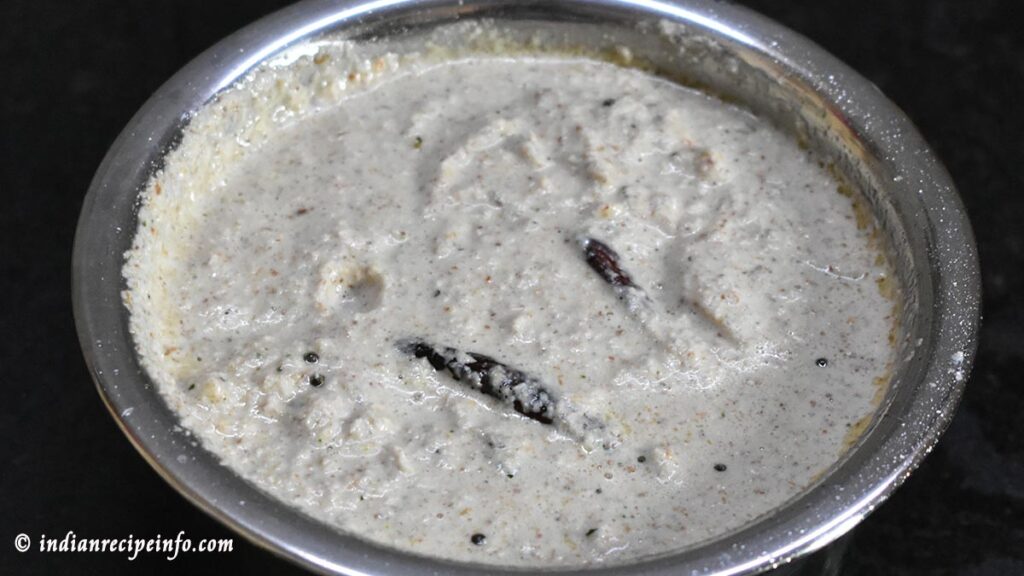
About Peanut Coconut Chutney Recipe
Peanut Coconut Chutney Recipe is a popular South Indian condiment that adds a burst of flavor and texture to various dishes. It’s made by blending together a combination of grated coconut, roasted peanuts, spices, and herbs. This chutney is known for its creamy consistency, nutty taste, and versatility in complementing a wide range of Indian dishes.
Serving:
- Coconut Peanut Chutney is a versatile condiment that pairs well with various South Indian dishes such as dosa, idli, vada, uttapam, and even rice. It’s often served as a side accompaniment, enhancing the overall taste of the meal.
- You can also use this chutney as a spread for sandwiches, wraps, or as a dipping sauce for snacks.
Variations:
- Some variations might include using dry red chilies instead of green chilies for a different level of spiciness.
- Adjust the proportion of coconut and peanuts to balance the flavors based on your preference.
- For a touch of sweetness, you can add a small amount of jaggery or grated carrots.
Here are a few finger-licking recipes:
Tomato Chutney and
How to make peanut coconut chutney recipe:
1. Heat 2 tbsp. oil in a pan and add green chilies. Roast for a while and once they are fried, transfer to another bowl.
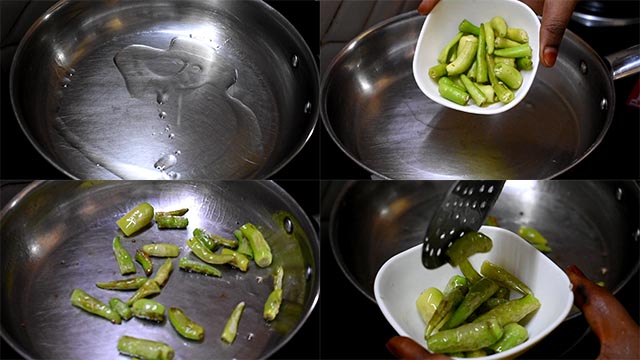
2. In remaining oil put peanuts and roast for a while, once they turn crisp transfer to another plate.
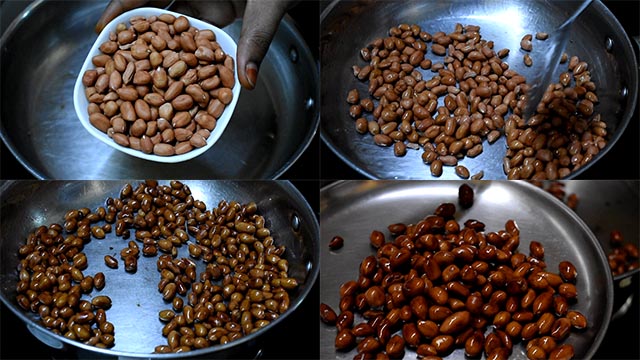
3. Put fresh coconut in a mixer bowl, add fried green chiles, cumin seeds and garlic cloves.
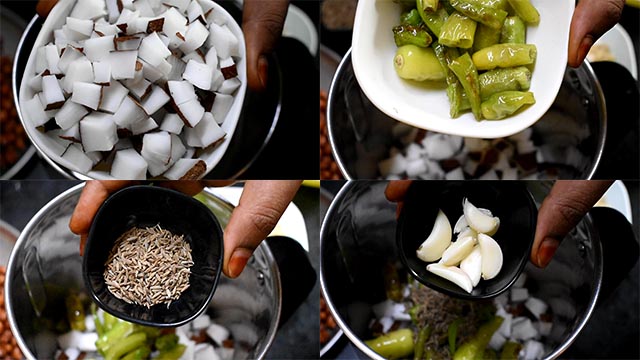
4. Add crystal salt and 2 tbsp. curry leaves. Close the lid and grind coarsely.
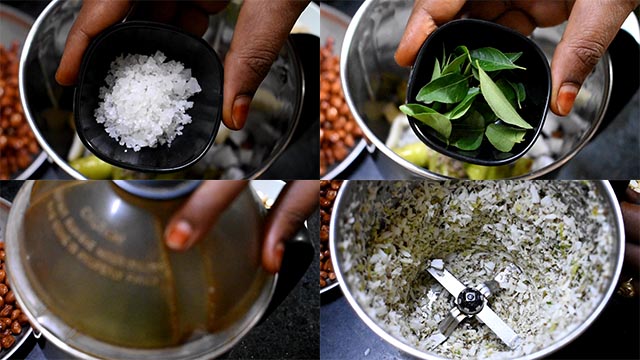
5. Put roasted peanuts and roasted gram dal. Once they are coarsely ground add little water to get soft paste. Transfer to another bowl.
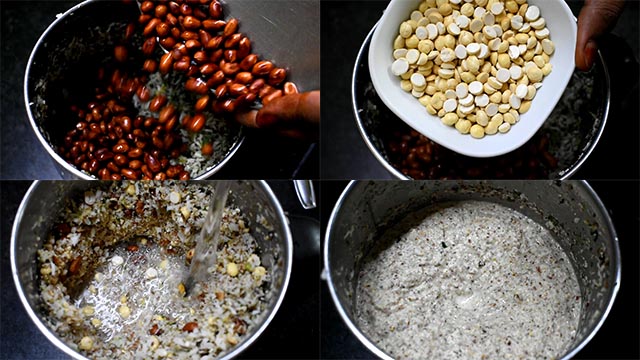
6. Heat oil in a tadka pan, add chana dal, moong dal and mustard seeds.
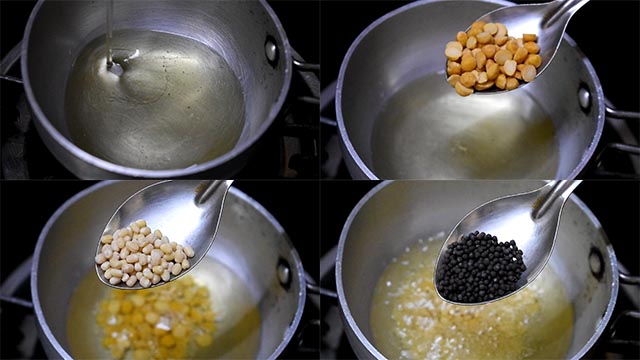
7. Add dry red chilies, 3 tbsp. curry leaves and asafetida (Hing). Put this tadka in coconut peanut chutney recipe and mix well.
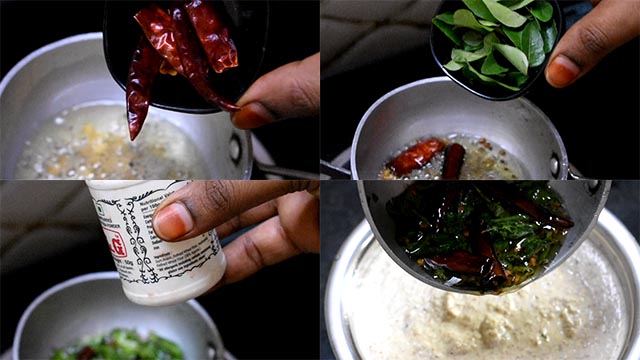
Watch this recipe video on >> Youtube.
Pro-Tips:
1. Use Fresh Ingredients: Always use fresh ingredients, especially grated coconut and peanuts. Fresh ingredients will contribute to the best flavor and texture of the chutney.
2. Roasting Peanuts: Roast the peanuts until they are evenly golden brown. Over-roasting can lead to a bitter taste. Allow them to cool before using to ensure a smooth blend.
3. Adjust Spice Level: The spiciness of the chutney comes from the green chilies. You can adjust the number of chilies to your taste preferences. If you prefer milder heat, you can remove the seeds from the chilies.
4. Balance Flavors: Achieve a balance between the nuttiness of the peanuts, the sweetness of the coconut, and the tanginess from tamarind or lemon juice. Taste the chutney and adjust the salt, tamarind, or lemon juice as needed.
5. Tempering Technique: When tempering (seasoning) the chutney, heat the oil sufficiently and add mustard seeds. Wait until they start to pop before adding urad dal and curry leaves. This step enhances the flavor of the chutney.
6. Texture and Consistency: Blend the ingredients with enough water to achieve a creamy consistency, but don’t make it too runny. The chutney should coat a spoon without dripping too quickly.
7. Using Blender or Grinder: Use a high-quality blender or grinder to ensure a smooth and even blend. If needed, you can add a little water in intervals to facilitate blending.
8. Optional Additions: You can enhance the flavor by adding a small piece of ginger for freshness or a clove of garlic for additional depth. Some variations even include a small amount of roasted cumin seeds for extra aroma.
9. Fresh Curry Leaves: Fresh curry leaves are integral to South Indian flavors. Including them in the tempering adds an aromatic touch to the chutney.
10. Experiment with Herbs: If you like, you can add chopped cilantro (coriander) leaves to the chutney after blending. They add a burst of freshness.
11. Adjust Texture Before Serving: If the chutney thickens after sitting for a while, you can adjust the consistency by adding a little water and blending briefly before serving.
12. Serving Temperature: Serve Coconut Peanut Chutney at room temperature or slightly chilled, depending on your preference and the dish you’re serving it with.
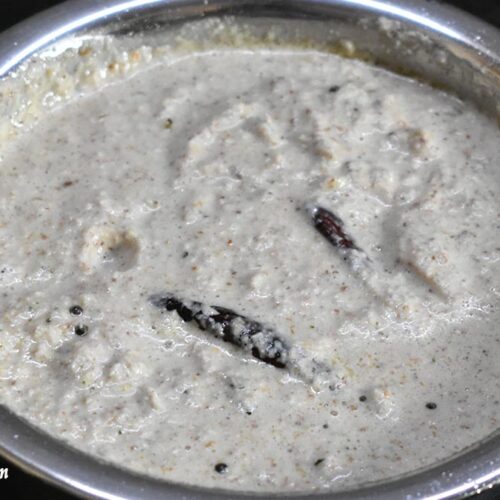
Peanut Coconut Chutney Recipe Card
Peanut Coconut Chutney Recipe is apopular South Indian condiment made by blending fresh coconut, roasted peanuts,roasted gram dal and spices.
Ingredients
- Coconut – 1 cup
- Peanut – 1 cup
- Roasted gram dal/ putnalu – ½ cup
- Oil – 6 tbsp.
- Green chilies – ½ cup
- Cumin seeds – 1 tbsp.
- Garlic cloves – 8 No.
- Crystal Salt – 1 tbsp.
- Curry leaves – 5 tbsp.
- Water – required
- Chana dal – ½ tbsp.
- Moong dal – ½ tbsp.
- Mustard seeds – ½ tbsp.
- Dry red chilies – 2 No.
Instructions
- Heat 2 tablespoons oil in a skillet and add green chilies. Roast for a few minutes, then transfer to another bowl.
- In the remaining oil, toast the peanuts until crisp, then transfer to a separate plate.
- In a mixing dish, combine fresh coconut, fried green chiles, cumin seeds, and garlic cloves.
- Season with crystal salt and 2 tablespoons curry leaves. Close the cover and coarsely grind.
- Add the roasted peanuts and gramme dal. Once coarsely mashed, add a little water to make a soft paste. Transfer to a different bowl.
- In a tadka pan, heat the oil and add the chana dal, moong dal, and mustardseeds.
- Stir in the dry red chilies, curry leaves, and asafetida (Hing). Mix this tadka into the coconut peanut chutney mixture.
Recipe Video
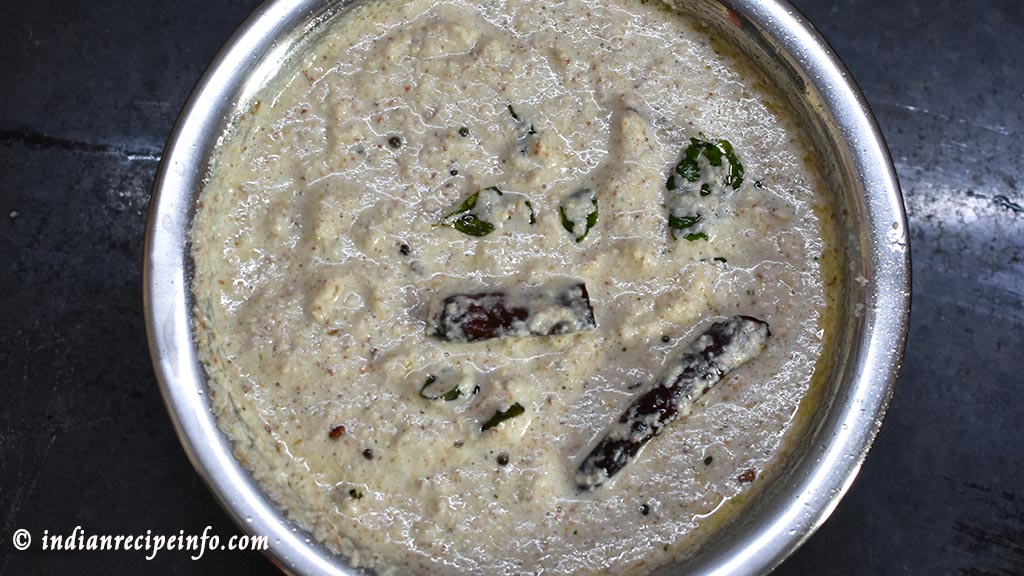
FAQ
1. What is Coconut Peanut Chutney? Coconut Peanut Chutney is a South Indian condiment made by blending together grated coconut, roasted peanuts, spices, and herbs. It’s a flavorful and creamy chutney often served as an accompaniment to various Indian dishes.
2. What dishes can I pair Coconut Peanut Chutney with? Coconut Peanut Chutney is a versatile condiment that pairs well with South Indian dishes like dosa, idli, vada, uttapam, and even rice. It can also be used as a dip for snacks or a spread for sandwiches.
3. Can I use desiccated coconut instead of fresh coconut? While fresh coconut provides the best flavor, you can use desiccated coconut in a pinch. However, fresh coconut is recommended for an authentic taste.
4. How do I adjust the spiciness of the chutney? The spiciness comes from the green chilies. To adjust the heat level, you can vary the number of chilies used or remove the seeds for milder spiciness.
5. Is Coconut Peanut Chutney vegan-friendly? Yes, Coconut Peanut Chutney is typically vegan as it doesn’t contain any animal-derived ingredients.
6. Can I make the chutney ahead of time? While it’s best enjoyed fresh, you can prepare Coconut Peanut Chutney a few hours ahead of time and store it in the refrigerator. However, note that the flavors might intensify as it sits.
7. How can I make the chutney less spicy? To make the chutney less spicy, you can reduce the number of green chilies used or opt for milder chili varieties.
8. Can I freeze Coconut Peanut Chutney? Freezing can alter the texture of the chutney, but you can store it in an airtight container in the refrigerator for a few days.
9. Can I add other spices for extra flavor? While the traditional recipe uses green chilies, roasted peanuts, and coconut, you can experiment with adding other spices like roasted cumin seeds or a pinch of asafoetida for unique flavor profiles.
10. How do I temper Coconut Peanut Chutney? Tempering involves heating oil, adding mustard seeds, letting them splutter, and then adding urad dal and curry leaves. Pour the tempered mixture over the chutney and mix well.
11. Can I make the chutney without tamarind or lemon juice? Tamarind or lemon juice adds tanginess to the chutney. If unavailable, you can use a small amount of vinegar or amchur (dried mango powder) as a substitute.
12. Can I make Coconut Peanut Chutney without peanuts for allergies? If you have peanut allergies, you can substitute roasted chana dal (split chickpeas) or roasted sesame seeds for the peanuts.
13. How can I achieve the right consistency of the chutney? Gradually add water while blending to achieve the desired consistency. The chutney should be creamy and smooth, but not too thin.
14. Can I add fruits or vegetables to the chutney for extra nutrition? While Coconut Peanut Chutney traditionally includes coconut and peanuts, you can experiment by adding small quantities of vegetables like carrot or fruits like mango for added nutrients and flavor.
15. What’s the shelf life of Coconut Peanut Chutney? Coconut Peanut Chutney can be refrigerated for a few days, but it’s best consumed fresh for optimal taste and texture.





